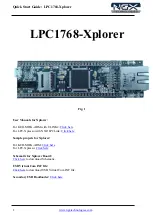
http://www.tyan.com
139
I/O (Input/Output):
the connection between your computer and another piece of
hardware (mouse, keyboard, etc.)
IRQ (Interrupt Request):
an electronic request that runs from a hardware device to
the CPU. The interrupt controller assigns priorities to incoming requests and
delivers them to the CPU. It is important that there is only one device hooked up to
each IRQ line; doubling up devices on IRQ lines can lock up your system. Plug-n-
Play operating systems can take care of these details for you.
Latency:
the amount of time that one part of a system spends waiting for another
part to catch up. This occurs most commonly when the system sends data out to a
peripheral device and has to wait for the peripheral to spread (peripherals tend to
be slower than onboard system components).
NVRAM:
ROM and EEPROM are both examples of Non-Volatile RAM, memory that
holds its data without power. DRAM, in contrast, is volatile.
Parallel port:
transmits the bits of a byte on eight different wires at the same time.
PCI (Peripheral Component Interconnect):
a 32 or 64-bit local bus (data pathway)
which is faster than the ISA bus. Local buses are those which operate within a
single system (as opposed to a network bus, which connects multiple systems).
PCI PIO (PCI Programmable Input/Output) modes:
the data transfer modes used
by IDE drives. These modes use the CPU for data transfer (in contrast, DMA
channels do not). PCI refers to the type of bus used by these modes to
communicate with the CPU.
PCI-to-PCI Bridge:
allows you to connect multiple PCI devices onto one PCI slot.
Pipeline burst SRAM:
a fast secondary cache. It is used as a secondary cache
because SRAM is slower than SDRAM, but usually larger. Data is cached first to
the faster primary cache, and then, when the primary cache is full, to the slower
secondary cache.
PnP (Plug-n-Play):
a design standard that has become ascendant in the industry.
Plug-n-Play devices require little set-up to use. Devices and operating systems that
are not Plug-n-Play require you to reconfigure your system each time you add or
change any part of your hardware.
PXE (Preboot Execution Environment):
one of four components that together
make up the Wired for Management 2.0 baseline specification. PXE was
designed to define a standard set of preboot protocol services within a client with
the goal of allowing networked-based booting to boot using industry standard
protocols.
Summary of Contents for S7106
Page 11: ...http www tyan com 11 2 1 Board Image S7106GM2NR...
Page 13: ...http www tyan com 13 2 2 Block Diagram S7106 Block Diagram...
Page 14: ...http www tyan com 14 2 3 Motherboard Mechanical Drawing...
Page 46: ...http www tyan com 46 3 3 2 Intel R Virtual RAID on CPU...
Page 52: ...http www tyan com 52...
Page 53: ...http www tyan com 53...
Page 76: ...http www tyan com 76 3 4 1 3 PCH SATA Configuration Submenu...
Page 79: ...http www tyan com 79 3 4 1 4 PCH sSATA Configuration Submenu...
Page 84: ...http www tyan com 84 3 4 3 Server ME Configuration Submenu Read Only...
Page 91: ...http www tyan com 91 3 5 3 2 UPI Status Configuration Submenu...
Page 93: ...http www tyan com 93 3 5 4 1 Memory Topology Configuration Submenu...
Page 100: ...http www tyan com 100 3 5 5 3 Intel VMD technology Submenu...
Page 110: ...http www tyan com 110 3 6 2 BMC Network Configuration Submenu...
Page 131: ...http www tyan com 131 BIOS Temp Sensor Name Explanation...
Page 132: ...http www tyan com 132...
Page 135: ...http www tyan com 135 NOTE...


































